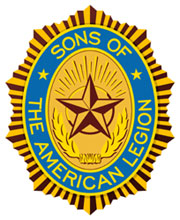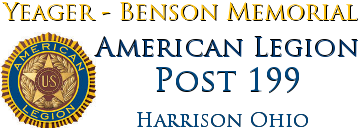 Sons of the American Legion
Sons of the American Legion
History
Born in the midst of the Great Depression of the 1930’s, and almost killed by the one-two punch of two wars, the Sons of The American Legion lives on. The idea of a junior American Legion organization was first discussed at the Legion’s 3rd National Convention in 1922. Because so few Legionnaires had yet become parents, the idea had little national appeal. But by the late 1920’s, Legion Posts around the nation were enrolling Sons of Legionnaires in junior organizations on their own. These groups were variously known as Legion-Heirs, the Junior Legion, Sons of American Legionnaires, and Sons of World War Veterans.
The Legion’s 1930 National Convention created a committee to study the feasibility of a junior Legion. The establishment of the Sons as a non-profit, nonsectarian civilian organization was authorized by action of The American Legion’s 14th National Convention in Portland, Oregon in September 1932. The 1933 National Convention officially changed the name of the organization to “The Sons of The American Legion,” authorized the abbreviation “S.A.L.” and set annual national membership dues at 25 cents.
The first Squadron chartered was Bruce P. Robison Post #133 in Indianapolis, Indiana. The very first membership card was issued to John P. Ragsdale; his brothers Edward and Robert were also charter members and received cards #2 and #3. John was killed in an aerial mission over Germany in 1943. In 1946, the name of the Post was changed to Robison-Ragsdale Post 133. By 1934, the S.A.L. expanded to 24 Detachments, 170 Squadrons, and 524 members. In the late 1930’s, Sons were closely involved with Legionnaires in nationwide radio programs and printed a monthly national newspaper called “The Legion Heir.” There were over 60,000 members in 1938 when Paramount Pictures released a film entitled “Sons of The Legion” starring Donald O’Connor, William Frawley, and Evelyn Keyes. The movie played in thousands of theaters around the country where local S.A.L. musical units furnished live entertainment.
The S.A.L. had over 70,000 members in the late 30’s and was growing rapidly. But World War II erupted and most Sons marched off, many of them never returned. Sons who remained on the home front also did their part working in civil defense, helping to operate aircraft warning posts, participating in war bond drives, collecting scrap metals and working in defense plants.
When Sons returned home after World WarII, they found their military service had made them eligible to join the ranks of The American Legion. In the decade between 1946 and 1956, an era, which included the Korean War, millions of ex-servicemen and women, joined The American Legion. Paradoxically, as the ranks of The Legion swelled, membership in the Sons dropped to fewer than 6,000 and the organization flirted with extinction.
Only through the efforts of dedicated Legion Family members did the S.A.L. turn around. In 1958, membership inched passed the 10,000 mark then climbed to nearly 17,000 in the early 1960’s. The Legion’s 441 National Convention in October 1962 appointed a special study group to revamp the structure of the Sons. A study group met in April 1963 and recommended increasing dues to 50 cents per member, eliminated military sounding S.A.L. officer titles and designated an official S.A.L. uniform. The study group met again in January 1964 and recommended updating the S.A.L. Constitution, initiating membership awards and revising the S.A.L. handbook.
The Sons’ first National S.A.L. Workshop was conducted during the Legion’s 1964 National Convention in Dallas. National Workshops continued annually through 1967, and then were replaced by National Caucuses, which were held annually through 1971. All Past National Caucus Chairmen are now recognized as Past National Commanders of the S.A.L. In 1972, the Legion’s National Executive Committee approved the creation of a national S.A.L. organization under the full supervision and control of the Legion’s N.E.C., thus opening the door for the Sons of The American Legion to hold their first National Convention in Chicago in August 1972. Robert Faust of California was elected the 1st National Commander of the Sons.
Sons celebrated their 50th Anniversary in 1982. At the S.A.L. National Convention in Chicago that year, the Sons held a Gala Golden Anniversary Banquet. A 501 Anniversary Book and special commemorative lapel pins were issued and the movie “Sons of The Legion,” produced in 1938, was shown.
In 1992, the S.A.L. National Organization began a reorganization of its commissions and committees. Various committees were placed under the oversight of one of six national commissions for the purpose of coordinating activities. Under this new structure, the S.A.L. established Squadron Americanism Awards in 1993, Scholastic Awards for Boys Nation and Junior Shooting Sports in 1994, and re-established the S.A.L. National Color Guard Award in 1996.
The Sons conducted their first Training Institute for Detachment Commanders in 1995, providing state officers with valuable leadership skills and managerial expertise. At their 1996 National Convention in Salt Lake City, Sons celebrated their Silver Anniversary National Convention. That same year, S.A.L. members nationwide contributed more than $116,000 to the American Legion’s Child Welfare Foundation, making them the largest contributor to the Foundation that year.
Every year since the establishment of the National Organization in 1972, the S.A.L. has recorded new all-time membership records. In 1990, membership in the Sons exceeded 100,000 for the first time ever. S.A.L. membership broke the 200,000 mark in 1997.

